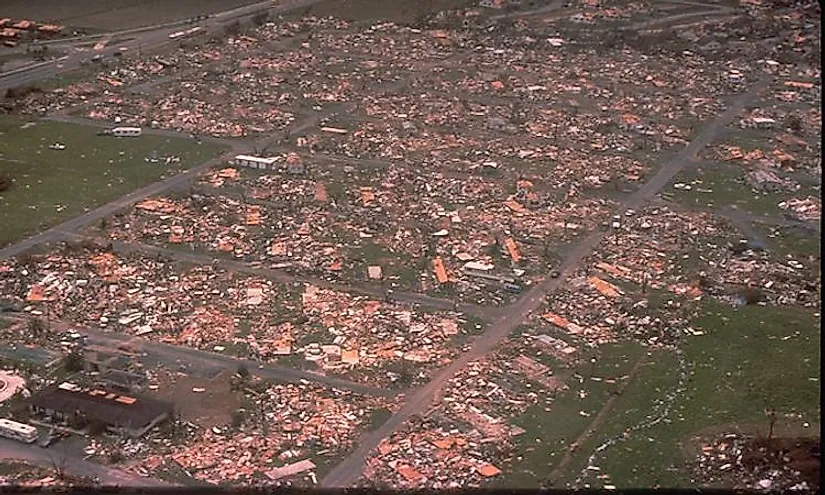Costliest Atlantic Hurricanes In History

Hurricane Damage
Hurricanes, tropical cyclones with winds over 74 miles per hour (mph), can often lead to extreme property damage and even loss of life. At sea, these storms cause large waves and extreme thunderstorms that disrupt marine activity, often resulting in shipwrecks. When hurricanes make landfall, their winds knock down trees, flatten buildings, and destroy power lines. In addition, the storm surge creates flooding in coastal areas. The rains also lead to flooding further inland, and after the storm, this can leave standing water that contributes to the spread of disease and mosquito-borne illnesses. Once hurricanes die down, affected areas are left with intense damage to infrastructure. Repairing these damages can cost governments and private citizens millions of dollars. This article takes a look at some of the costliest hurricanes in history.
The 5 Costliest Hurricanes In The Atlantic
Hurricane Katrina
The costliest Atlantic hurricane in history is Hurricane Katrina. This storm hit the Bahamas and the US in 2005 and left $125 billion in damages. Much of this damage was caused by the massive storm surge along the coast from Florida to Texas. Also, New Orleans experienced over 50 levee and floodwall failures that contributed to flooding. The coastlines flooded with waters reaching between 6 and 12 miles inland in many places. It was the cause of at least 1,836 deaths. Reported disasters stretched over 90,000 square miles. The flooding and winds destroyed cars, roads, bridges, and homes. In addition to the damages, an estimated $150 billion in economic losses is thought to have occurred. Oil and gas production was decreased, the timber industry was affected due to forest damage, and thousands of people were without jobs as businesses were closed. Over 1 million people from the Gulf Coast region were forced to move to other cities, considered the largest diaspora in US history.
Hurricane Sandy
Hurricane Sandy had a total of $75 billion in damages. This hurricane ripped through the Caribbean, the US east coast, and eastern Canada in 2012. Its winds spread across 1,100 miles, making it the largest recorded Atlantic hurricane. An estimated 233 people were killed throughout 8 countries. The hurricane crossed Jamaica and got stronger before hitting Cuba. It weakened before heading through the Bahamas and then made landfall in New Jersey, moved across the US, and into Canada. Throughout these countries, residents were left without electricity, homes were damaged, and flooding led to food shortages. Over the US, a cold front made an impact on the hurricane and created blizzard conditions in some areas. Public transportation systems, including trains and planes, were shut down or canceled between October 27 and November 1. The United Nations, World Food Programme, and the American Red Cross contributed to relief efforts.
Hurricane Ike
Hurricane Ike of 2008 left behind $37.5 billion in damages as it moved through the Greater Antilles, Texas, Louisiana, and the midwestern region of the US. Not only did this hurricane destroy infrastructure, but also agriculture. Approximately 195 people were killed. Bridges washed away, roofs were torn away from buildings, and people lost power. Oil refineries in the Gulf were closed down, leading to an increase in gas prices. While waiting for relief aid, many people were forced to live in hotels or with family in other cities, sometimes for months at a time.
Hurricane Wilma
Hurricane Wilma hit just 2 months after the previously mentioned Hurricane Katrina. It caused $29.3 billion in damages and affected the Greater Antilles, Central America, and Florida. Most of the destruction was in the Yucatan Peninsula of Mexico, Cuba, and Florida. In total, 87 deaths were reported. Heavy rains caused mudslides, power lines collapsed, and even evacuation shelters were destroyed. Tornadoes ripped through cities on the western edge of the hurricane. Flooding washed out bridges and took cars away. Economically, the areas hit lost income from halted sugarcane production, destroyed citrus crops, and declines in tourism.
Hurricane Andrew
The fifth costliest hurricane in the Atlantic was Hurricane Andrew. This 1992 hurricane crossed the Bahamas, Florida, and the Gulf Coast, leaving $26.5 billion in damages. Approximately 65 fatalities are attributed to this storm. Its storm surge, winds, and tornadoes left behind some of the worst damages seen in that time. Oil drilling platforms in the Gulf of Mexico were affected, causing over $500 million in losses. Insurance companies went bankrupt due to extensive claims filed. International aid was sent to the Bahamas, including from the US. Many areas in the US were declared disaster zones with the US National Guardsman being deployed for relief and reconstruction.
The Costliest Hurricanes Of The Atlantic
| Rank | Name | Damage (Billions USD) | Season | Storm classification at peak intensity |
|---|---|---|---|---|
| 1 | Katrina | $125.0 | 2005 | Category 5 hurricane |
| 2 | Sandy | $75.0 | 2012 | Category 3 hurricane |
| 3 | Ike | $37.5 | 2008 | Category 4 hurricane |
| 4 | Wilma | $29.3 | 2005 | Category 5 hurricane |
| 5 | Andrew | $26.5 | 1992 | Category 5 hurricane |
| 6 | Ivan | $23.3 | 2004 | Category 5 hurricane |
| 7 | Irene | $16.6 | 2011 | Category 3 hurricane |
| 8 | Charley | $15.1 | 2004 | Category 4 hurricane |
| 9 | Rita | $12.0 | 2005 | Category 5 hurricane |
| 10 | Frances | $9.85 | 2004 | Category 4 hurricane |











